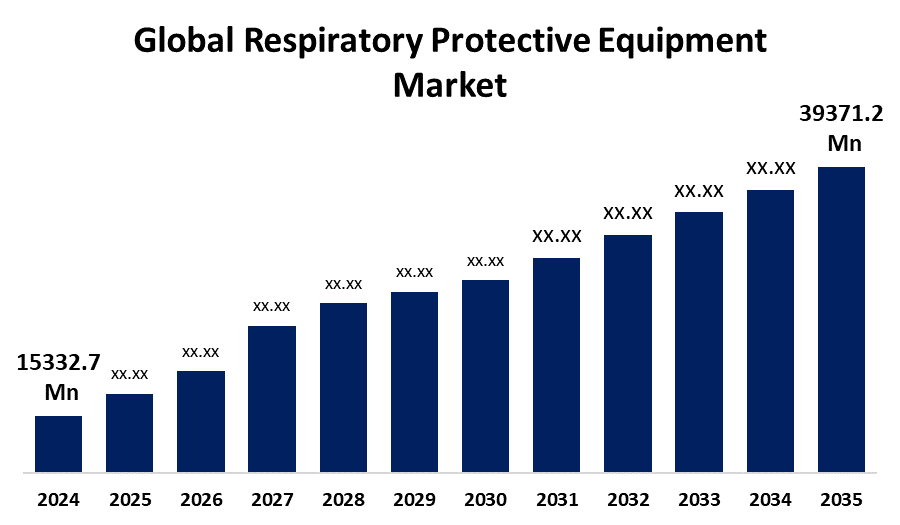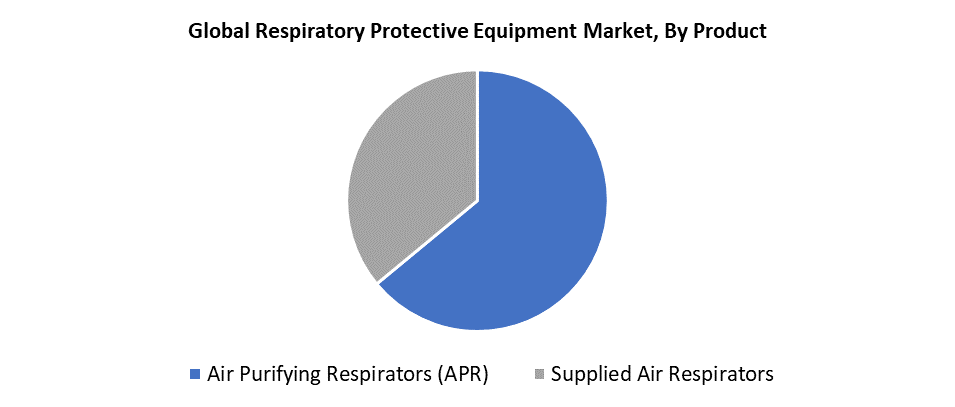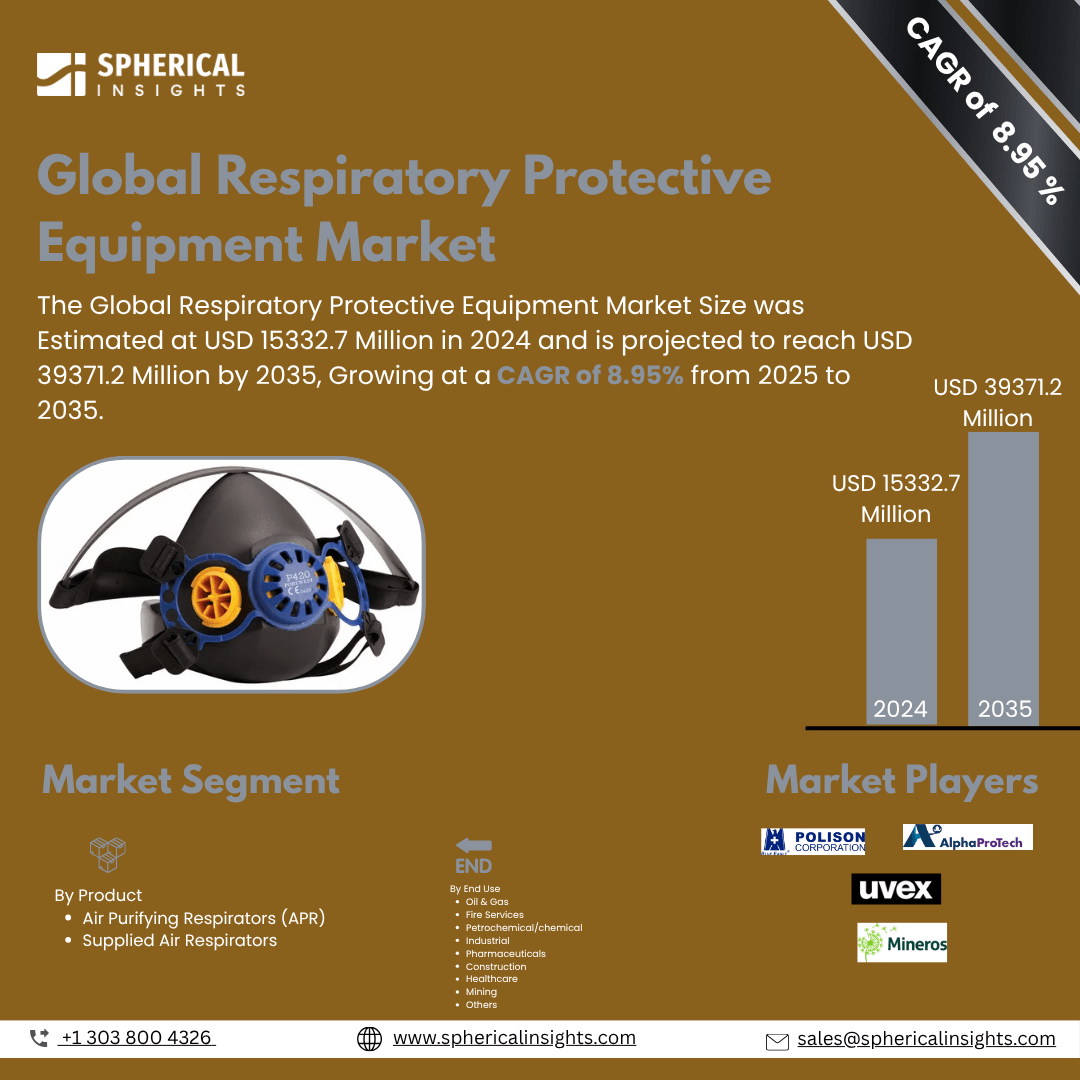Respiratory Protective Equipment Market Summary
The Global Respiratory Protective Equipment Market Size was Estimated at USD 15332.7 Million in 2024 and is projected to reach USD 39371.2 Million by 2035, growing at a CAGR of 8.95% from 2025 to 2035. The market for respiratory protective equipment (RPE) is expanding as a result of a number of factors, such as the rise of infectious diseases, growing industrialization, and increased awareness of workplace safety. The growth of the market is also significantly influenced by strict government regulations and developments in RPE technology.
Key Regional and Segment-Wise Insights
- In 2024, North America held the greatest revenue share of 28.3% in the respiratory protection equipment market.
- In 2024, the air-purifying respirator (APR) segment had the highest market share by product, accounting for 64.7%.
- In 2024, the healthcare industry segment had the biggest market share by end-use, accounting for 20.6%.
Global Market Forecast and Revenue Outlook
- 2024 Market Size: USD 15332.7 Million
- 2035 Projected Market Size: USD 39371.2 Million
- CAGR (2025-2035): 8.95%
- North America: Largest market in 2024
- Asia Pacific: Fastest-growing region

The respiratory protective equipment (RPE) market consists of the industry that designs, manufactures, distributes, and sells equipment that protects people from inhaling harmful agents in the air while at work. The increasing desire for safer and better working environments has propelled the use of respiratory protective equipment (RPE) as the global awareness continues to grow. Environmental issues, stricter safety regulations, and growing concerns about air pollution are driving forces behind the growth of the market. The growth of RPE demand is also promoted by improvements in health care, especially after natural disasters such as volcanic eruptions or wildfires, which have higher risks of respiratory exposure. The older population is also an impetus for adoption due to the increased risk of respiratory issues. There are multiple reasons for continued growth in the RPE industry, including increased legislation and ongoing attention to the safety of workers in an occupational context.
The COVID-19 pandemic caused manufacturers to expand their production of respiratory protection equipment (RPE) and especially disposable masks because of the sudden surge in demand. The industry continues to grow because organizations across various sectors prioritize worker health and safety. The global implementation of more stringent safety standards forces businesses to purchase superior quality RPE for legal compliance in high-risk sectors, including manufacturing and mining, as well as construction. The drive toward regulatory compliance, together with rising worker well-being concerns, leads to significant industry expansion. A handful of dominant corporations maintain control over the RPE market, which remains fairly concentrated. These major corporations use advanced technologies and worldwide distribution networks to maintain their market advantage and ensure their industry expansion.
Product Insights

The global air-purifying respirator (APR) market generated more than 64.7% of its total revenue through 2024. The air purifier respirator represents specialized respiratory protection equipment that removes harmful airborne contaminants while maintaining continuous delivery of purified air to users. The mask contains built-in air purification devices, which typically include filters and cartridges, while sometimes using a motorized fan to maintain clean air flow. The pandemic created a massive surge in disposable mask requirements that strengthened the market growth for N95 and surgical masks. The market demand for these products will maintain its strength beyond the epidemic because healthcare workers and emergency responders require them. Half-mask APRs serve as a standard protective equipment for emergency services personnel, together with workers in mining operations and healthcare settings.
The supplied air respirator (SARs) market is growing steadily over the forecasted period. A significant factor is the increasing demand in hazardous environments where negative pressure or lack of adequate protection from powered air purifying respirators (PAPRs) is a concern. The primary factor driving this growth will be the growth of the chemical, pharmaceutical, and oil and gas sectors in the Asia Pacific region. SARs give the proper protection in potentially hazardous environments by supplying clean air continuously from a source apart from the wearer, eliminating the need for a filter. A major trend in the SARs market is the increased use of cutting-edge technologies that enhance comfort, communication, and compatibility with other PPE to adapt to the evolving needs of industries such as health care, construction, and manufacturing.
End Use Insights

The healthcare industry generated 20.6% of worldwide revenue in 2024, making it the leading market for respiratory protection equipment. Healthcare organizations increased their respiratory protection equipment requirements because of infectious diseases such as COVID-19, Influenza A (H1N1), and Ebola, which spread worldwide. The forecast period will witness sustained growth because healthcare personnel, including physicians, nurses, and support personnel, continue facing respiratory hazards. Healthcare personnel need respiratory protection equipment to shield themselves from infectious diseases, harmful drugs, and airborne infections. The market offers surgical masks together with N95 respirators and powered air-purifying respirators (PAPRs). The expanding market stems from increased infection control priorities and flexible respiratory protection requirements for both patient safety and worker health. The pandemic-driven awareness about industrial worker safety has driven rapid growth in RPE demand.
The demand for respiratory protection equipment (RPE) in the construction industry is anticipated to grow significantly over the forecast period. Governments worldwide are implementing financial stimulus measures to boost infrastructure development while controlling pandemic-related economic consequences, thus driving construction activity upward. The protection of construction workers' health depends on RPE because these workers face daily hazards from silica dust, lead dust, and silica vapors. RPE is crucial to protecting the health of construction workers because they are regularly exposed to respiratory risks such as silica dust, lead dust, and silica vapors.
Regional Insights
North America led the respiratory protection equipment market, accounting for 28.3% of global sales in 2024. In recent years, the entry of RPE products into new markets has increased due to a growing number of industries, including electric power utilities, oil and gas drilling, and industries with flammable dust that use RPE. The growth of the market is also caused by greater awareness of the dangers to respiratory health, especially in industrial and healthcare settings. The increase in consumption of respirators and face masks for respiratory health protection is also significant, allowing for further market growth in the region. North America's higher market share is attributed to the adoption of innovative respiratory protection technology, established major players, and commitment to health and safety compliance that generally exists in the region.
U.S. Respiratory Protective Equipment Market Trends
The North American respiratory protection equipment (RPE) market in 2024 was dominated by the United States, accounting for 80.6% market share because of its strong industrial infrastructure and firm occupational safety regulations. RPE serves essential functions across healthcare and manufacturing, and construction sectors because government bodies such as OSHA impose mandatory safety standards for worker protection. The United States maintains its global leadership position in developing protective technologies that enhance the effectiveness, comfort, and efficiency of respiratory equipment. The pandemic led to an increased focus on employee health and safety, together with rising environmental concerns, which created sustained high demand for RPE. The U.S. market will continue to develop due to a mix of increased safety awareness, technical advancement, and regulatory assistance.
Europe Respiratory Protective Equipment Market Trends
The RPE industry in Europe is largely developed and regulated due to strict occupational health and safety regulations. RPE is required in high-risk sectors like manufacturing, construction, and healthcare due to the enforcement of stringent standards by regulatory agencies like the European Agency for Safety and Health at Work. The region’s solid industrial base, along with increased awareness of environmental and health concerns, ensures ongoing demand for RPE. Furthermore, the RPE market is steadily expanding due to Europe's continuous investments in workplace safety, which are fueled by both legal mandates and a greater emphasis on employee welfare. Innovations in protective gear and technological developments also continue to influence the European market environment.
Asia Pacific Respiratory Protective Equipment Market Trends
During the forecast period, the Asia Pacific respiratory protection equipment (RPE) market grow at the fastest CAGR because of industrial growth and increasing health awareness in the region. Governments, together with businesses, are implementing stricter safety regulations to combat air pollution and occupational dangers while responding to rising respiratory disorders. Mining and construction, along with manufacturing facilities throughout the region, have adopted RPE because of the region's evolving regulatory standards. The different economies across Asia Pacific, which range from developed countries to developing markets generate changing demand patterns that help drive the RPE market growth. The market will maintain its growth trajectory because of rising safety standards and public understanding.
Key Respiratory Protective Equipment Companies:
The following are the leading companies in the respiratory protective equipment market. These companies collectively hold the largest market share and dictate industry trends.
- 3M
- Polison Corporation
- Alpha Pro Tech Limited
- Uvex Safety Group
- Intech Safety Pvt. Ltd.
- Avon Rubber plc
- MSA Safety Incorporated
- Delta Plus Group
- Honeywell International Inc.
- ILC Dover LP
- Ansell Ltd.
- Bullard
- Kimberly-Clark Corporation
- DuPont
- Gateway Safety, Inc.
- Others
Recent Developments
- In March 2025, Dräger, a prominent company specializing in safety technology, presents its new ProAir CCBA, which has NIOSH certification for continuous oxygen delivery that lasts four hours. The advanced solution represents the next step in breathing equipment technology from more than 100 years of experience, and it aims to transform Federal Government operations in dangerous situations, including confined spaces, underground areas, below-deck ship disasters, and HAZMAT operations.
- In January 2025, 3M has joined Direct Relief to supply essential respiratory protection following the terrible wildfires that struck Los Angeles. The corporation has pledged to deliver 5 million N95 respirators to Direct Relief to support its humanitarian work during wildfire seasons. The respirators have been strategically pre-positioned in Los Angeles to guarantee immediate distribution to affected population groups. Local health clinics, together with the YMCA and other charitable organizations, take on the responsibility of distributing these supplies. The program aims to safeguard first responders and residents who face wildfire smoke exposure through protective measures for their respiratory health.
Market Segment
This study forecasts revenue at global, regional, and country levels from 2020 to 2035. Spherical Insights has segmented the respiratory protective equipment market based on the below-mentioned segments:
Global Respiratory Protective Equipment Market, By Product
- Air Purifying Respirators (APR)
- Supplied Air Respirators
Global Respiratory Protective Equipment Market, By End Use
- Oil & Gas
- Fire Services
- Petrochemical/chemical
- Industrial
- Pharmaceuticals
- Construction
- Healthcare
- Mining
- Others
Global Respiratory Protective Equipment Market, By Regional Analysis
- North America
- Europe
- Germany
- UK
- France
- Italy
- Spain
- Russia
- Rest of Europe
- Asia Pacific
- China
- Japan
- India
- South Korea
- Australia
- Rest of Asia Pacific
- South America
- Brazil
- Argentina
- Rest of South America
- Middle East & Africa
- UAE
- Saudi Arabia
- Qatar
- South Africa
- Rest of the Middle East & Africa






